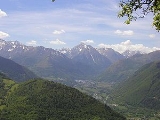
Quatre-Vallées
Encyclopedia
Quatre-Vallées (Gascon
: Quate-Vaths) was a small province of France located in the southwest of France
. It was made up of four constituent parts: Aure valley (Gascon: Aura), Barousse valley (Gascon: Varossa), Magnoac valley (Gascon: Manhoac), and Neste or Nestès valley (Gascon: Nèsta or Nestés).
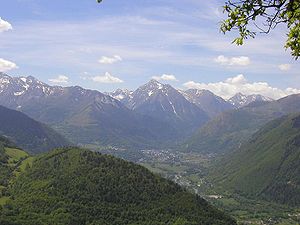 The Aure and Barousse
The Aure and Barousse
valleys are contiguous. The Neste valley is also contiguous with Barousse and Aure, but most of the Neste valley was under the jurisdiction of Gascony
and Comminges
, and there were only two small enclaves in the Neste Valley that were part of the Quatre-Vallées province, these two enclaves being surrounded by villages under the jurisdiction of Gascony and Comminges, and physically separated from the Aure and Barousse valleys. The Aure, Barousse, and Neste valleys are all located in the Pyrenees
mountains, in the southeast of the present-day département of Hautes-Pyrénées
.
The Magnoac valley is located further north in the hilly countryside of Gascony, and is now the northeast of Hautes-Pyrénées. Magnoac was separated from Aure and Barousse by 19 km.(12 miles) of land not part of Quatre-Vallées.
Thus, the Quatre-Vallée province was altogether made up of four geographically detached parts, from south to north:
However, politically and administratively speaking, and no matter whether contiguous or detached, the four constituent parts of the Quatre-Vallée province were, from south to north:
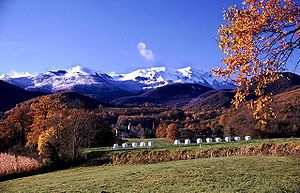 Quatre-Vallées had a land area of 878 km²
Quatre-Vallées had a land area of 878 km²
(339 sq. miles), 58% being Aure, 22% being Magnoac, 17% being Barousse, and 3% being Neste. At the 1999 French census, there were 13,451 inhabitants on the territory of the former Quatre-Vallées province, 42% of these in Aure, 28% in Magnoac, 17% in Barousse, and 13% in Neste. The average density is thus very low for Europe, at 15 inh. per km² (40 inh. per sq. mile), ranging from 11 inh. per km² (28 inh. per sq. mile) in the Aure valley to 75 inh. per km² (194 inh. per sq. mile) in the Neste valley.
There is no urban area on the territory of the former Quatre-Vallées province. In 1999 the largest villages were La Barthe-de-Neste
(1,056 inhabitants) in the Neste valley and the ski resort of Saint-Lary-Soulan
(1,024 inhabitants) in the Aure valley.
, the valleys of Aure, Barousse, Neste, and Magnoac were detached from Comminges in the 11th century and were divided between the counts of Aure, vassal
s of the kings of Aragon, and the counts of Astarac
(in Gascony). The line of the counts of Aure ended in 1242 without a male heir, and the county of Aure was inherited by the counts of Labarthe (residing in La Barthe-de-Neste
), who by then possessed the three other valleys of Neste, Barousse, and Magnoac. Thus, the four valleys were unified under the counts of Labarthe, and began to be known as Quatre-Vallées. The counts of Labarthe were vassals of the kings of Aragon, and so Quatre-Vallées was part of the kingdom of Aragon
.
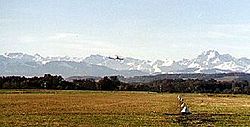 In June 1300, Count Bernard of Labarthe granted the 53 articles of the "Statutes, Customs, and Privileges of the Country of Quatre-Vallées". These statutes, written in the native Romance
In June 1300, Count Bernard of Labarthe granted the 53 articles of the "Statutes, Customs, and Privileges of the Country of Quatre-Vallées". These statutes, written in the native Romance
language of the inhabitants, were quite ahead of their time: they granted full liberty to the inhabitants of the Quatre-Vallées, free ownership of land, free use of communal ovens, free usage of the forests, and so on, as well as the right to be ruled by consuls representing the people. All these privileges and liberties were unprecedented in rural areas of medieval Europe, and were normally found only in chartered cities. The Statutes of 1300 are the origin of the special privileges and distinct character that the Quatre-Vallées kept until the French Revolution
.
The Quatre-Vallées were a buffer zone between the county of Comminges and the powerful county of Armagnac
(in Gascony), and were coveted by both, until eventually in 1398 they became a possession of the counts of Armagnac
. In 1462, Count Jean V of Armagnac
ceded the fief of Quatre-Vallées to his incest
uous sister Isabelle of Armagnac. Isabelle, who had given her fortune to charities, ended up in utter poverty, and on top of it she became paralyzed with hemiplegia
. Taking advantage of her weakness, Gaston de Lyon, Lord of Bezaudun and seneschal
of Toulouse, lured the poor Isabelle into selling him the Quatre-Vallées against 5,127 gold crowns (écu
s d'or), which he never paid, always postponing payment in the hope of a rapid death of Isabelle.
At the same time, in 1475, as the king of France obtained Roussillon
from the king of Aragon, the Quatre-Vallées were officially detached from the kingdom of Aragon
and entered the kingdom of France. However, they were still not part of the royal domain, and were just one of the many independent fiefs of the kingdom of France.
Eventually, the maneuvering of Gaston de Lyon alerted higher authorities. Gaston de Lyon then sent his private doctor to Isabelle, and this one saw to it that she would not live long enough to embarrass his master. In August 1476, the paralyzed and forlorn Isabelle of Armagnac, who in her youth had been promised to the king of England, died in horrible pain after drinking a potion prepared by the doctor to "cure" her. She was only 45. Gaston de Lyon immediately claimed the Quatre-Vallées. His attitude was so revolting that the duke of Alençon and the duke of Vendôme, relatives of Isabelle of Armagnac, sued Gaston de Lyon to prevent him from obtaining the Quatre-Vallées. The trial lasted for more than a century. At last, ruined and discouraged, the descendants of Gaston de Lyon ceded the Quatre-Vallées to Henry III of Navarre, who owned many Pyrenean fiefs (Béarn
, Lower Navarre
, Bigorre
, County of Foix
, Nébouzan
).
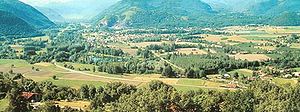 In 1589, Henry III of Navarre became king Henry IV of France
In 1589, Henry III of Navarre became king Henry IV of France
. In 1607, he united to the French crown those of his personal fiefs that were under French sovereignty (i.e. County of Foix, Bigorre, Quatre-Vallée, and Nébouzan, but not Béarn and Lower Navarre, which were sovereign countries outside of the kingdom of France), and so Quatre-Vallées became part of the royal domain
. Nonetheless, Quatre-Vallées kept all its privileges granted in the Middle Ages
, and it also kept its provincial states until the French Revolution
, which decided freely what was the level of taxation and how much was given to the king. The provincial states of Quatre-Vallées, made up of only ten members, met once a year in an inn at Garaison, a famous pilgrimage center where the Virgin Mary was said to have appeared in the beginning of the 16th century. Garaison is located in the commune of Monléon-Magnoac
, in the Magnoac valley. However, Arreau
, the capital of the Aure valley, is often considered by local people to be the capital of Quatre-Vallées.
At the start of the French Revolution, the Quatre-Vallées remained quiet. They had been freed and exempted from feudal taxes and corvée
s for centuries already, and so they did not demand equality and the end of privileges like the other parts of France did. At first it was planned that Quatre-Vallées would gather with the provinces of Nébouzan
and Comminges
, and that the three would elect common representatives to the Estates-General
in Versailles
. The Quatre-Vallées saw this as a breach of their Statutes and autonomy, and they sent a letter of protest to Versailles. Eventually, they were allowed to send their own representative to the Estates-General. This representative was assigned the task of preserving the privileges of the Quatre-Vallées at all cost. However, there was not much he could do when feudalism and all the privileges were abolished by the French National Constituent Assembly
in the night of August 4, 1789, and so the Quatre-Vallées lost their old privileges.
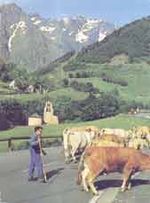 In 1790, when the départements were created, the Quatre-Vallées were too small to become a département, and against the wishes of their inhabitants, who wished to join with Comminges and Nébouzan to form a département, the Quatre-Vallées were joined with Bigorre
In 1790, when the départements were created, the Quatre-Vallées were too small to become a département, and against the wishes of their inhabitants, who wished to join with Comminges and Nébouzan to form a département, the Quatre-Vallées were joined with Bigorre
, as well as with a fragment of Nébouzan and parts of Gascony, to form the département of Hautes-Pyrénées
. The people of Quatre-Vallées objected bitterly, stressing the old historical and economic ties with Comminges, but it was to no avail. After that, the people of the Quatre-Vallées returned to their isolated and self-supporting lifestyle, away from the new trends and political changes that France experienced in the 19th century.
The area remained very traditional well into the 20th century, and modernity progressed only slowly. Like the rest of the Pyrenees, Quatre-Vallées suffered a lot from rural exodus
. Today, the low population density of the Quatre-Vallées have turned them into a haven for nature lovers and people wishing to discover some of the wildest parts of the Pyrenees, where a spectacular landscape is combined with a rich historical heritage and many old monuments.
Gascon language
Gascon is usually considered as a dialect of Occitan, even though some specialists regularly consider it a separate language. Gascon is mostly spoken in Gascony and Béarn in southwestern France and in the Aran Valley of Spain...
: Quate-Vaths) was a small province of France located in the southwest of France
France
The French Republic , The French Republic , The French Republic , (commonly known as France , is a unitary semi-presidential republic in Western Europe with several overseas territories and islands located on other continents and in the Indian, Pacific, and Atlantic oceans. Metropolitan France...
. It was made up of four constituent parts: Aure valley (Gascon: Aura), Barousse valley (Gascon: Varossa), Magnoac valley (Gascon: Manhoac), and Neste or Nestès valley (Gascon: Nèsta or Nestés).
General characteristics

Barousse valley
The Barousse is a small region of southwestern France, including the valley of the Ourse, a left tributary of the Garonne, in the Hautes-Pyrénées, and the smaller valley of Siradan.The main towns are Loures-Barousse and Mauleon-Barousse.-Toponymy:...
valleys are contiguous. The Neste valley is also contiguous with Barousse and Aure, but most of the Neste valley was under the jurisdiction of Gascony
Gascony
Gascony is an area of southwest France that was part of the "Province of Guyenne and Gascony" prior to the French Revolution. The region is vaguely defined and the distinction between Guyenne and Gascony is unclear; sometimes they are considered to overlap, and sometimes Gascony is considered a...
and Comminges
Comminges
The Comminges is an ancient region of southern France in the foothills of the Pyrenees, corresponding closely to the arrondissement of Saint-Gaudens in the department of Haute-Garonne...
, and there were only two small enclaves in the Neste Valley that were part of the Quatre-Vallées province, these two enclaves being surrounded by villages under the jurisdiction of Gascony and Comminges, and physically separated from the Aure and Barousse valleys. The Aure, Barousse, and Neste valleys are all located in the Pyrenees
Pyrenees
The Pyrenees is a range of mountains in southwest Europe that forms a natural border between France and Spain...
mountains, in the southeast of the present-day département of Hautes-Pyrénées
Hautes-Pyrénées
Hautes-Pyrénées is a department in southwestern France. It is part of the Midi-Pyrénées region.-History:...
.
The Magnoac valley is located further north in the hilly countryside of Gascony, and is now the northeast of Hautes-Pyrénées. Magnoac was separated from Aure and Barousse by 19 km.(12 miles) of land not part of Quatre-Vallées.
Thus, the Quatre-Vallée province was altogether made up of four geographically detached parts, from south to north:
- Aure and Barousse valleys
- Neste valley (enclave #1)
- Neste valley (enclave #2)
- Magnoac valley
However, politically and administratively speaking, and no matter whether contiguous or detached, the four constituent parts of the Quatre-Vallée province were, from south to north:
- Aure valley
- Barousse valleyBarousse valleyThe Barousse is a small region of southwestern France, including the valley of the Ourse, a left tributary of the Garonne, in the Hautes-Pyrénées, and the smaller valley of Siradan.The main towns are Loures-Barousse and Mauleon-Barousse.-Toponymy:...
- Neste valley
- Magnoac valley

1 E8 m²
To help compare different orders of magnitude and geographical regions, listed below are areas between 100 km2 and 1000 km2. See also areas of other orders of magnitude.* Areas less than 100 km2* 100 km2 is equal to:** 1 E+8 m²...
(339 sq. miles), 58% being Aure, 22% being Magnoac, 17% being Barousse, and 3% being Neste. At the 1999 French census, there were 13,451 inhabitants on the territory of the former Quatre-Vallées province, 42% of these in Aure, 28% in Magnoac, 17% in Barousse, and 13% in Neste. The average density is thus very low for Europe, at 15 inh. per km² (40 inh. per sq. mile), ranging from 11 inh. per km² (28 inh. per sq. mile) in the Aure valley to 75 inh. per km² (194 inh. per sq. mile) in the Neste valley.
There is no urban area on the territory of the former Quatre-Vallées province. In 1999 the largest villages were La Barthe-de-Neste
La Barthe-de-Neste
La Barthe-de-Neste is a commune in the Hautes-Pyrénées department in south-western France.-References:*...
(1,056 inhabitants) in the Neste valley and the ski resort of Saint-Lary-Soulan
Saint-Lary-Soulan
Saint-Lary-Soulan is a commune in the Hautes-Pyrénées department in south-western France.-Geography:Saint-Lary is located in Hautes-Pyrénées 80 km south of the départements capital Tarbes, next to the Le Néouvielle Nature Reserve and the Pyrenees National Park and is a 20 minute drive to...
(1,024 inhabitants) in the Aure valley.
History
Originally part of CommingesComminges
The Comminges is an ancient region of southern France in the foothills of the Pyrenees, corresponding closely to the arrondissement of Saint-Gaudens in the department of Haute-Garonne...
, the valleys of Aure, Barousse, Neste, and Magnoac were detached from Comminges in the 11th century and were divided between the counts of Aure, vassal
Vassal
A vassal or feudatory is a person who has entered into a mutual obligation to a lord or monarch in the context of the feudal system in medieval Europe. The obligations often included military support and mutual protection, in exchange for certain privileges, usually including the grant of land held...
s of the kings of Aragon, and the counts of Astarac
Astarac
Astarac is a region in Gascony, a county in the Middle Ages. It was formed as a county out of the partition of the Duchy of Gascony amongst his son following the death of García II Sánchez. The youngest son, Arnold I, received Astarac....
(in Gascony). The line of the counts of Aure ended in 1242 without a male heir, and the county of Aure was inherited by the counts of Labarthe (residing in La Barthe-de-Neste
La Barthe-de-Neste
La Barthe-de-Neste is a commune in the Hautes-Pyrénées department in south-western France.-References:*...
), who by then possessed the three other valleys of Neste, Barousse, and Magnoac. Thus, the four valleys were unified under the counts of Labarthe, and began to be known as Quatre-Vallées. The counts of Labarthe were vassals of the kings of Aragon, and so Quatre-Vallées was part of the kingdom of Aragon
Kingdom of Aragon
The Kingdom of Aragon was a medieval and early modern kingdom in the Iberian Peninsula, corresponding to the modern-day autonomous community of Aragon, in Spain...
.

Romance languages
The Romance languages are a branch of the Indo-European language family, more precisely of the Italic languages subfamily, comprising all the languages that descend from Vulgar Latin, the language of ancient Rome...
language of the inhabitants, were quite ahead of their time: they granted full liberty to the inhabitants of the Quatre-Vallées, free ownership of land, free use of communal ovens, free usage of the forests, and so on, as well as the right to be ruled by consuls representing the people. All these privileges and liberties were unprecedented in rural areas of medieval Europe, and were normally found only in chartered cities. The Statutes of 1300 are the origin of the special privileges and distinct character that the Quatre-Vallées kept until the French Revolution
French Revolution
The French Revolution , sometimes distinguished as the 'Great French Revolution' , was a period of radical social and political upheaval in France and Europe. The absolute monarchy that had ruled France for centuries collapsed in three years...
.
The Quatre-Vallées were a buffer zone between the county of Comminges and the powerful county of Armagnac
Armagnac (region)
The hilly countship of Armagnac , in the foothills of the Pyrenées between the Adour and Garonne rivers, is a historic countship of the Duchy of Gascony, established in 601 in Aquitaine...
(in Gascony), and were coveted by both, until eventually in 1398 they became a possession of the counts of Armagnac
Count of Armagnac
The following is a list of rulers of the county of Armagnac:-House of Armagnac:*William Count of Fézensac and Armagnac ?– 960*Bernard the Suspicious, First count privative of Armagnac 960– ?*Gerald I Trancaléon ? –1020*Bernard I Tumapaler 1020–1061...
. In 1462, Count Jean V of Armagnac
Jean V of Armagnac
John V of Armagnac , the next-to-last Count of Armagnac of the older branch, was the controversial son of John IV of Armagnac and Isabella of Navarre, an emblem of 15th century aristocratic violence, treachery and indiscipline, a wildman from one of the most powerful virtually independent...
ceded the fief of Quatre-Vallées to his incest
Incest
Incest is sexual intercourse between close relatives that is usually illegal in the jurisdiction where it takes place and/or is conventionally considered a taboo. The term may apply to sexual activities between: individuals of close "blood relationship"; members of the same household; step...
uous sister Isabelle of Armagnac. Isabelle, who had given her fortune to charities, ended up in utter poverty, and on top of it she became paralyzed with hemiplegia
Hemiplegia
Hemiplegia /he.mə.pliː.dʒiə/ is total paralysis of the arm, leg, and trunk on the same side of the body. Hemiplegia is more severe than hemiparesis, wherein one half of the body has less marked weakness....
. Taking advantage of her weakness, Gaston de Lyon, Lord of Bezaudun and seneschal
Seneschal
A seneschal was an officer in the houses of important nobles in the Middle Ages. In the French administrative system of the Middle Ages, the sénéchal was also a royal officer in charge of justice and control of the administration in southern provinces, equivalent to the northern French bailli...
of Toulouse, lured the poor Isabelle into selling him the Quatre-Vallées against 5,127 gold crowns (écu
Écu (coin)
The term écu may refer to one of several French coins. The first écu was a gold coin minted during the reign of Louis IX of France, in 1266. Ecu means shield, and the coin was so called because its design included a shield bearing a coat of arms. The word is related to scudo and escudo...
s d'or), which he never paid, always postponing payment in the hope of a rapid death of Isabelle.
At the same time, in 1475, as the king of France obtained Roussillon
Roussillon
Roussillon is one of the historical counties of the former Principality of Catalonia, corresponding roughly to the present-day southern French département of Pyrénées-Orientales...
from the king of Aragon, the Quatre-Vallées were officially detached from the kingdom of Aragon
Kingdom of Aragon
The Kingdom of Aragon was a medieval and early modern kingdom in the Iberian Peninsula, corresponding to the modern-day autonomous community of Aragon, in Spain...
and entered the kingdom of France. However, they were still not part of the royal domain, and were just one of the many independent fiefs of the kingdom of France.
Eventually, the maneuvering of Gaston de Lyon alerted higher authorities. Gaston de Lyon then sent his private doctor to Isabelle, and this one saw to it that she would not live long enough to embarrass his master. In August 1476, the paralyzed and forlorn Isabelle of Armagnac, who in her youth had been promised to the king of England, died in horrible pain after drinking a potion prepared by the doctor to "cure" her. She was only 45. Gaston de Lyon immediately claimed the Quatre-Vallées. His attitude was so revolting that the duke of Alençon and the duke of Vendôme, relatives of Isabelle of Armagnac, sued Gaston de Lyon to prevent him from obtaining the Quatre-Vallées. The trial lasted for more than a century. At last, ruined and discouraged, the descendants of Gaston de Lyon ceded the Quatre-Vallées to Henry III of Navarre, who owned many Pyrenean fiefs (Béarn
Béarn
Béarn is one of the traditional provinces of France, located in the Pyrenees mountains and in the plain at their feet, in southwest France. Along with the three Basque provinces of Soule, Lower Navarre, and Labourd, the principality of Bidache, as well as small parts of Gascony, it forms in the...
, Lower Navarre
Lower Navarre
Lower Navarre is a part of the present day Pyrénées Atlantiques département of France. Along with Navarre of Spain, it was once ruled by the Kings of Navarre. Lower Navarre was historically one of the kingdoms of Navarre. Its capital were Saint-Jean-Pied-de-Port and Saint-Palais...
, Bigorre
Bigorre
Bigorre is region in southwest France, historically an independent county and later a French province, located in the upper watershed of the Adour, on the northern slopes of the Pyrenees, part of the larger region known as Gascony...
, County of Foix
County of Foix
The County of Foix was an independent medieval fief in southern France, and later a province of France, whose territory corresponded roughly the eastern part of the modern département of Ariège ....
, Nébouzan
Nébouzan
Nébouzan was a small province of France located in the foothills of the Pyrenees mountains, in the southwest of France. It was not a contiguous province, but it was made up of several detached territories, approximately half of them around the town of Saint-Gaudens in the south of the present-day...
).

Henry IV of France
Henry IV , Henri-Quatre, was King of France from 1589 to 1610 and King of Navarre from 1572 to 1610. He was the first monarch of the Bourbon branch of the Capetian dynasty in France....
. In 1607, he united to the French crown those of his personal fiefs that were under French sovereignty (i.e. County of Foix, Bigorre, Quatre-Vallée, and Nébouzan, but not Béarn and Lower Navarre, which were sovereign countries outside of the kingdom of France), and so Quatre-Vallées became part of the royal domain
Crown lands of France
The crown lands, crown estate, royal domain or domaine royal of France refers to the lands, fiefs and rights directly possessed by the kings of France...
. Nonetheless, Quatre-Vallées kept all its privileges granted in the Middle Ages
Middle Ages
The Middle Ages is a periodization of European history from the 5th century to the 15th century. The Middle Ages follows the fall of the Western Roman Empire in 476 and precedes the Early Modern Era. It is the middle period of a three-period division of Western history: Classic, Medieval and Modern...
, and it also kept its provincial states until the French Revolution
French Revolution
The French Revolution , sometimes distinguished as the 'Great French Revolution' , was a period of radical social and political upheaval in France and Europe. The absolute monarchy that had ruled France for centuries collapsed in three years...
, which decided freely what was the level of taxation and how much was given to the king. The provincial states of Quatre-Vallées, made up of only ten members, met once a year in an inn at Garaison, a famous pilgrimage center where the Virgin Mary was said to have appeared in the beginning of the 16th century. Garaison is located in the commune of Monléon-Magnoac
Monléon-Magnoac
Monléon-Magnoac is a commune in the Hautes-Pyrénées department in south-western France.-References:*...
, in the Magnoac valley. However, Arreau
Arreau
Arreau is a commune in the Hautes-Pyrénées department in south-western France.It is situated on the former Route nationale 618, the Route of the Pyrenees. Arreau is at the crossroads of the Louron valley and the Aure valley.-References:*...
, the capital of the Aure valley, is often considered by local people to be the capital of Quatre-Vallées.
At the start of the French Revolution, the Quatre-Vallées remained quiet. They had been freed and exempted from feudal taxes and corvée
Corvée
Corvée is unfree labour, often unpaid, that is required of people of lower social standing and imposed on them by the state or a superior . The corvée was the earliest and most widespread form of taxation, which can be traced back to the beginning of civilization...
s for centuries already, and so they did not demand equality and the end of privileges like the other parts of France did. At first it was planned that Quatre-Vallées would gather with the provinces of Nébouzan
Nébouzan
Nébouzan was a small province of France located in the foothills of the Pyrenees mountains, in the southwest of France. It was not a contiguous province, but it was made up of several detached territories, approximately half of them around the town of Saint-Gaudens in the south of the present-day...
and Comminges
Comminges
The Comminges is an ancient region of southern France in the foothills of the Pyrenees, corresponding closely to the arrondissement of Saint-Gaudens in the department of Haute-Garonne...
, and that the three would elect common representatives to the Estates-General
Estates-General of 1789
The Estates-General of 1789 was the first meeting since 1614 of the French Estates-General, a general assembly representing the French estates of the realm: the nobility, the Church, and the common people...
in Versailles
Versailles
Versailles , a city renowned for its château, the Palace of Versailles, was the de facto capital of the kingdom of France for over a century, from 1682 to 1789. It is now a wealthy suburb of Paris and remains an important administrative and judicial centre...
. The Quatre-Vallées saw this as a breach of their Statutes and autonomy, and they sent a letter of protest to Versailles. Eventually, they were allowed to send their own representative to the Estates-General. This representative was assigned the task of preserving the privileges of the Quatre-Vallées at all cost. However, there was not much he could do when feudalism and all the privileges were abolished by the French National Constituent Assembly
National Constituent Assembly
The National Constituent Assembly was formed from the National Assembly on 9 July 1789, during the first stages of the French Revolution. It dissolved on 30 September 1791 and was succeeded by the Legislative Assembly.-Background:...
in the night of August 4, 1789, and so the Quatre-Vallées lost their old privileges.

Bigorre
Bigorre is region in southwest France, historically an independent county and later a French province, located in the upper watershed of the Adour, on the northern slopes of the Pyrenees, part of the larger region known as Gascony...
, as well as with a fragment of Nébouzan and parts of Gascony, to form the département of Hautes-Pyrénées
Hautes-Pyrénées
Hautes-Pyrénées is a department in southwestern France. It is part of the Midi-Pyrénées region.-History:...
. The people of Quatre-Vallées objected bitterly, stressing the old historical and economic ties with Comminges, but it was to no avail. After that, the people of the Quatre-Vallées returned to their isolated and self-supporting lifestyle, away from the new trends and political changes that France experienced in the 19th century.
The area remained very traditional well into the 20th century, and modernity progressed only slowly. Like the rest of the Pyrenees, Quatre-Vallées suffered a lot from rural exodus
Rural exodus
Rural flight is a term used to describe the migratory patterns of peoples from rural areas into urban areas.In modern times, it often occurs in a region following the industrialization of agriculture when fewer people are needed to bring the same amount of agricultural output to market and related...
. Today, the low population density of the Quatre-Vallées have turned them into a haven for nature lovers and people wishing to discover some of the wildest parts of the Pyrenees, where a spectacular landscape is combined with a rich historical heritage and many old monuments.

